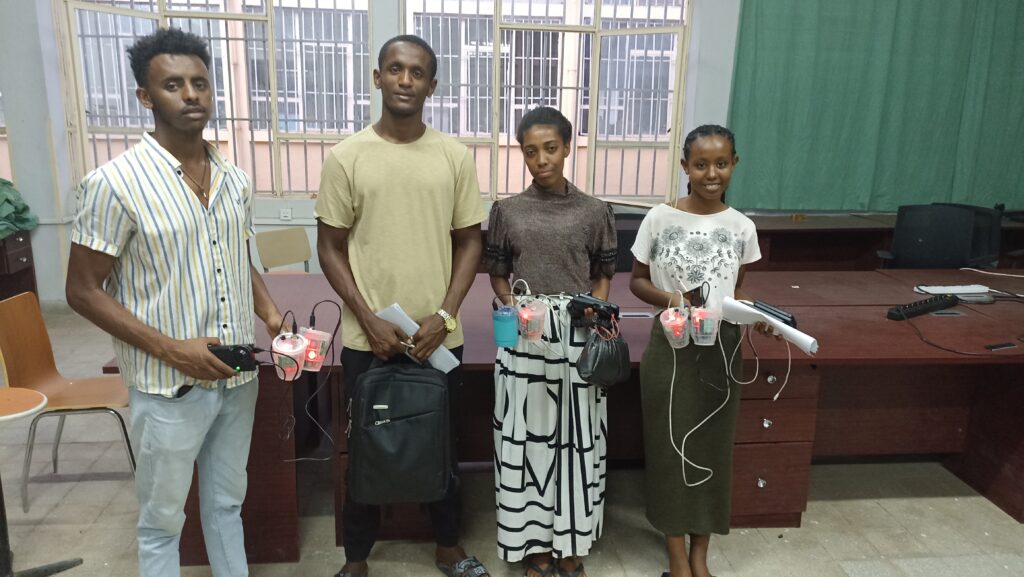
As a lecturer for Arba Minch University, it is my task to be involved both in research and in education. I decided to combine these two, by turning air pollution courses that I offer into research projects for students. This is a win-win situation: I get access to low-cost data collectors, while students get practical experience. In 2019 I used this approach for the first time, with some 180 students divided over four classes. By letting the students create measurement plans, collect data, and analyze and report it, 33 small research projects on a variety of air pollution topics were conducted in and around Arba Minch University campus. In our publication on this approach, we decided to name it ‘Student science‘: as a subset of citizen science, serving both educational and scientific goals.
Air pollution student science courses
Over the years 2019-2024, I have offered air pollution courses in which students designed measurement plans and collected air pollution data. I regularly change the research topic and project outline.
2019: I offered the courses Air, Noise and Soil Pollution and Atmospheric Chemistry and Air Quality. In groups of five, students selected a research question, picked a measurement instrument and pollutant, scheduled their measurement time, collected data, analyzed the data and reported on it. Students could use the IQAir Airvisual Pro for either PM2.5 or CO2, the UCB-PATS+ for high PM2.5, or the Lascal El-USB-CO for indoor CO. The project work went hand in hand with lectures on the course chapters. Measurements of this round of courses led to two publications: one on the student science method, and one on the data as collected by the students and its use for distinguishing priority areas.
2021: I offered the course Air, Noise and Soil pollution, while a colleague at the same time offered the course Research Methods. Students conducted a research project similar to the one in 2019 (self-selection of topics), but now this project was part of two courses. From my course, I could focus on air pollution contents as supporting lectures, while from the Research Methods course, the focus could be on research methods.
2022_A: I offered the course Air, Noise and Soil pollution, while three colleagues offered the course Research Methods. While in 2019 and 2021, students could freely select their topics, this year I picked three ‘grand topics’ (based on the measurements of earlier years). The three topics were: dormitory ventilation, restaurant kitchens and coffee ceremonies. Groups of students brainstormed on variables and related sub-topics under these three topics. Based on this, they constructed measurement plans, and collected, analyzed and presented data.
2022_B: simultaneously to the course Air, Noise and Soil pollution, I offered to another batch of students the course Air and Noise pollution. For this batch I had reserved the topic ‘traffic air pollution’. With groups of students, I brainstormed on sub-topics. For these students, we constructed six SPSA low-cost sensor systems (one per group). The groups could continuously use these sensor systems for a period of six weeks, during which they managed the data collection at various roadside locations. Measurements of these students led to one publication.
2023: I offered the course Air and Noise pollution to only twelve students. The focus of this year was ‘personal sampling’: students continuously kept track of their location, and kept with themselves instruments. They could use the IQAir Airvisual Pro for CO2 and PM2.5, the UCB-PATS+ for pM2.5. Some students also got an SPSA locally constructed sensor system. This SPSA was put into a big plastic mug, in order to make it wearable.
2024: I offered the course Air and Noise pollution to only 9 students. Like last year, the focus was on personal sampling. This year, my colleague constructed 9 wearable SPSA sensor systems (one per student), and the students continuously tracked their location and kept the sensor system with them.
Works
A list of public works with student science:
- Publication “An evaluation of best practices in an air quality student science project in Ethiopia”. Evaluation of the project run in the 2019 courses, with respect to best practices regarding scientific and educational goals.
- All underlying data and data processing code on an OSF repository
- Publication “Using student science to identify research priority areas for air pollution in a university environment: an Ethiopian case study”. Using the 2019 courses’ collected data to identify research priority areas.
- All underlying data and data processing code on an OSF repository
- Publication “Roadside PM2.5 concentrations measured with low-cost sensors and student science in Arba Minch, Ethiopia”. Students used the SPSA to monitor PM2.5 concentrations on and next to roads in Arba Minch.
- All underlying data and data processing code on an OSF repository
- Presentation “Student science as low-cost data collection method: evidence from Arba Minch” at the 18-20 December 2023 Workshop ‘Together for cleaner air in Ethiopia, an international conference in Addis Ababa.
- Presentation “Opportunities for research and education in a low-resource context: air pollution research as showcase” on the June 9-10 2023 Symposium on Sustainable Water Resources Development, at Arba Minch University.
Click here for all posts regarding student science.
Related work
I presented my experience with low-cost research methods in the field of air pollution to Arba Minch University staff and management. Based on this, with the office of the Vice President on Academic Affairs of Arba Minch University (AMU) we set up a student science call. As per September 2024, seven groups of staff across various AMU departments are planning to turn part of one of their courses into a research project.

